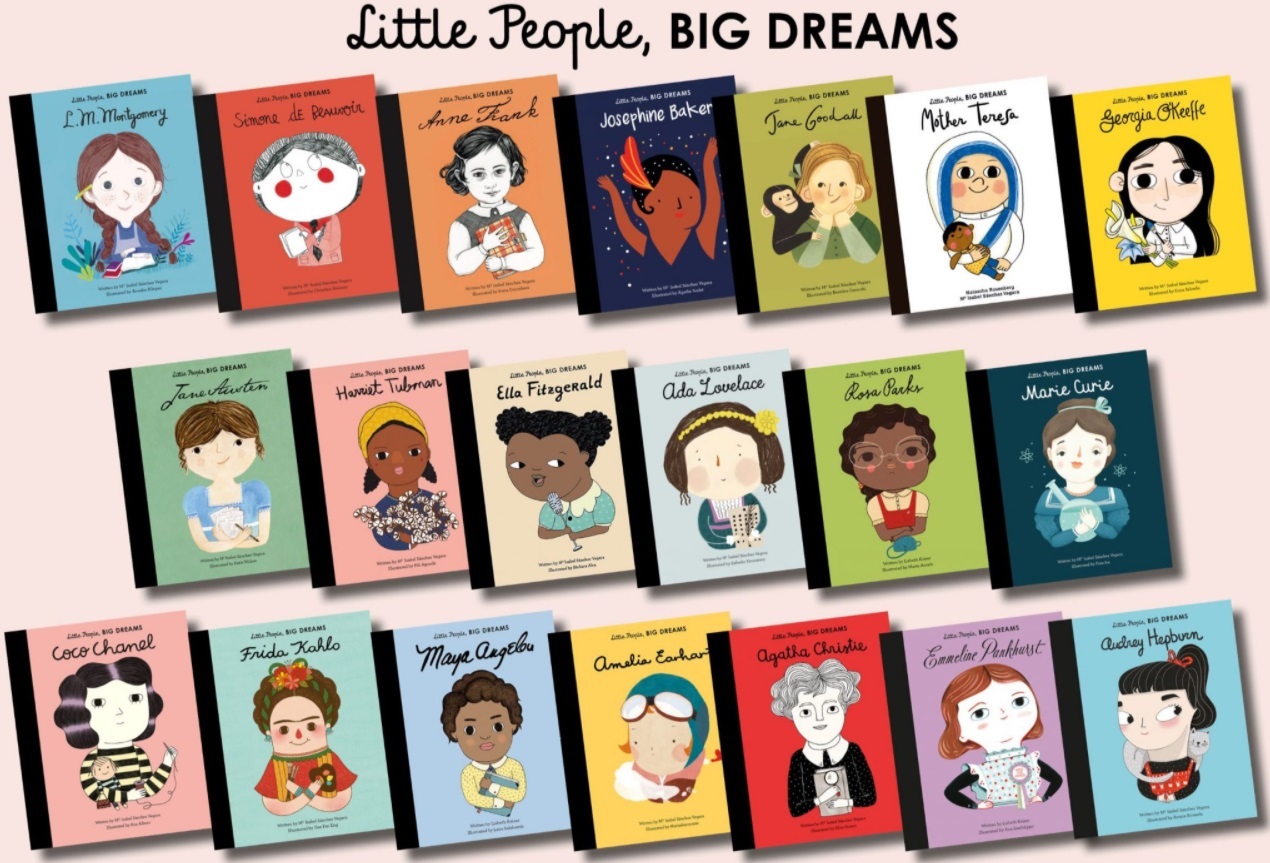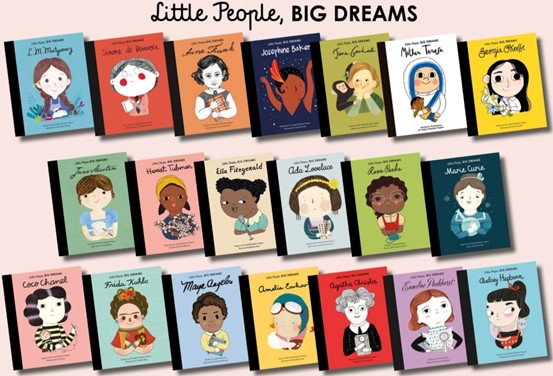Big dreams for little people
Posted on Sunday, June 30, 2019
Category: Reading Resources

The Little People, Big Dreams series, published by Frances Lincoln, are stylish books aimed at young readers (aged 5-9 years) about outstanding women and men, and the dreams that they held as children and which motivated them to achieve amazing things. We asked teachers and school librarians to tell us how they would use the books in class.
The Little People, Big Dreams series, published by Frances Lincoln, are stylish books aimed at young readers (aged 5-9 years) about outstanding women and men, and the dreams that they held as children and which motivated them to achieve amazing things. We asked teachers and school librarians to tell us how they would use the books in class.
The latest books to be added to the Little People, Big Dreams series include Charles Darwin and Mary Anning and footballers Megan Rapinoe and Pele, with earlier titles including Marie Curie, Frida Kahlo, Amelia Earhart, Maya Angelou and Coco Chanel.
As well as providing a simple, clear introduction to each woman and what shaped their achievements as adults, the books can be used to support a host of cross-curricular opportunities.

EMERGING READERS
Each book is beautifully produced, with bold-coloured covers edged with black cloth binding. "They are the perfect size for little hands to hold whilst being sturdy enough to be enjoyed time and time again," says teacher Sue Wilsher. "Each of the titles I looked at had been illustrated by a different person, adding an individual style to each text whilst the overall format matches."
The simple text used for each biography makes them perfect for the emergent reader. "The lives of these women are complex and often cover difficult subject matter and so their precising has needed considerable skill to stay true to the life without bombarding young children with too much detail," Wilsher adds.
DEVELOPING RESEARCH SKILLS
As well as making great stories to share at Key Stage 1, the books can be used with older pupils in KS2 for general reference and topic work or research-led activities, says teacher Lucy Newton. School librarian Emily Marcuccilli points to key features including a helpful timeline at the end of each book featuring further biographical information and photographs. Some of the titles also have a list of other books that readers might like to refer to for further information.
"These features in particular make this series of biographies perfect for independent research in Years 3 to 5," she says. "As a school librarian, I know that it is not always easy to magic up that elusive information book suitable for the primary-aged child researching, for example, women scientists or women in the civil rights movement."
INSPIRATIONAL BOOKS FOR PSHE
The inspirational nature of the books makes them ideal for assemblies and for PSHE. "Talking about their childhoods gives the books relevance to young children and helps them engage with the subject," says school librarian Jayne Gould. "It helps them to realise that people can have ambitions from early in their lives."
All the people featured in the series had to overcome obstacles of one kind or another, including poverty, prejudice [racial and in terms of what women were expected and allowed to do] and illness, which gives a strong message about perseverance and belief in oneself, says Gould. "This fits well into the PSHE /SCCM curriculum, where aspirations, inspirational people, cultural values, rights and responsibilities are discussed."
INSPIRING GIRLS AND BOYS
Wilsher adds, "So often history is written about men by men and although books about significant women are starting to appear, they are often aimed at older children. It is essential that both boys and girls see and recognise the contributions people of all genders, faiths, races and traditions have made to our world from as young an age as possible."
By offering examples of people (who in these cases happen to be women) who have overcome adversity and have pursued their dreams, teachers can raise questions about role models and heroes, what it is to make a contribution to your country, the world etc, says Wilsher. "They could be used to encourage discussion about how people treat one another, whether things should limit what a person can do and so on."
CROSS-CURRICULAR ACTIVITIES
The series also provides cross-curricular opportunities, from exploring biographies and developing research skills, to finding out about significant people from history, exploring art and design and learning about science.
HISTORY
For History, the KS1 Programme of Study asks that pupils are taught about 'the lives of significant individuals in the past who have contributed to national and international achievements'. Some should be used to compare aspects of life in different periods [for example, Elizabeth I and Queen Victoria, or Rosa Parks and Emily Davison etc.] "Any of the women featured in this series could be used as an example of a 'significant individual'," says Wilsher. "'Rosa Parks', for example, could also be used to teach them about changes within living memory and 'Emmeline Pankhurst' to teach about events beyond living memory that are significant nationally or globally."
Newton adds, "The library would definitely benefit from having the whole collection in the history section; children could use them for research on projects and teachers could take them out for learning projects that relate to them."
They can be used to develop work and ideas further up the age range, says teacher Lizi Coombs. "I would use the Emmeline Pankhurst book, for example, to introduce the topic of rights, and how women had to fight for the vote. With younger children, this book would probably be enough to get them thinking. With older children, Year 3 up, the book is a starting point to ensure that children have a basic knowledge of suffragettes and the votes for women campaign. I'd like to encourage them to do more research, to find out more about how the suffragettes rallied and then form their own arguments about whether it was successful or not."
ART AND DESIGN
Other cross-curricular opportunities include Art and Design, since children KS1 must be taught about the work of a range of artists, craft makers and designers; the books on Frida Kahlo and Coco Chanel could be used to introduce these artists while for older children, the books could be a starting point to explore the artist's style or to research the fashion industry.
SCIENCE
Many schools already teach children about scientist Marie Curie and the Little People, Big Dreams book about her gives a clear introduction to the work she did, which can be developed by older children with further research. "We recently had a science week at the school in which we had a day of Female Scientists - the Marie Curie title would be perfect for this!" says teacher Lauren Maidman.
POETRY
Writing and reading skills can also be supported with this series says Coombs, using the Maya Angelou book as an example. "This story would be good for talking about civil rights and for talking about equality of gender, but it can also be used effectively for introducing poetry as an art form. Quite often in schools, children come across generic rhyming poems, or just skim the surface of poetry. In the story we learn how Maya becomes mute and that it is only through discovering how words come alive in stories and poetry that she finds her voice again. This book would be a great way into getting children to look at poetry and stories as a way of expressing yourself, as escapism or as a way to explore other experiences."
WRITING DIARIES
Other writing activities the books could be used to inspire include, for example, creating non-chronological reports on famous women who have changed the world; writing diary entries on the role of one of the women from different points in their life; or writing a narrative based on one of the stories in more detail, suggests Newton.
Marcuccilli says the series provides "a beautiful and rich resource that would be ideal for reading aloud with a class of children of 5 years and up, or equally with one's own children at home". She adds, "These books can play a very useful role in the empowerment of girls and will encourage girls AND boys to follow their dreams and to stand up for what they believe in."
